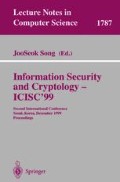Abstract
This paper introduces a cryptographic paradigm called self-escrowed encryption, a concept initiated by kleptography. In simple words, a self-escrowed public-key cryptosystem features the property that the scheme’s public and private keys are connected to each other by the mean of an other cryptosystem, called the master scheme. We apply this notion to the design of auto-recoverable auto-certifiable cryptosystems, a solution to software key escrow due to Young and Yung, and provide a new cryptographic escrow system called self-escrowed public key infrastructure. In addition, we give an example of such a system based on ElGamal and Paillier encryption schemes which achieves a high level of both efficiency and security.
Access this chapter
Tax calculation will be finalised at checkout
Purchases are for personal use only
Preview
Unable to display preview. Download preview PDF.
References
Camenisch, J., Michels, M.: Separability and Efficiency for Generic Group Signature Schemes. In: Wiener, M. (ed.) CRYPTO 1999. LNCS, vol. 1666, pp. 413–430. Springer, Heidelberg (1999)
Chan, A., Frankel, Y., Tsiounis, Y.: Easy Come-Easy Go Divisible Cash. In: Nyberg, K. (ed.) EUROCRYPT 1998. LNCS, vol. 1403, pp. 561–575. Springer, Heidelberg (1998)
Diffe, W., Hellman, M.: New Directions in Cryptography. IEEE Transactions on Information Theory IT-22(6), 644–654 (1976)
Fiat, A., Shamir, A.: How to Prove Yourself: Practical Solution to Identification and Signature Problems. In: Odlyzko, A.M. (ed.) CRYPTO 1986. LNCS, vol. 263, pp. 186–194. Springer, Heidelberg (1987)
Frankel, Y., Yung, M.: Escrow Encryption Systems Visited: Attacks, Analysis and Designs. In: Coppersmith, D. (ed.) CRYPTO 1995. LNCS, vol. 963, pp. 222–235. Springer, Heidelberg (1995)
Fujisaki, E., Okamoto, T.: Statistical Zero-knowledge Protocols to Prove Modular Polynomial Relations. In: Kaliski Jr., B.S. (ed.) CRYPTO 1997. LNCS, vol. 1294, pp. 16–30. Springer, Heidelberg (1997)
ElGamal, T.: A Public Key Cryptosystem and a Signature Scheme Based on Discrete Logarithms. IEEE Transactions on Information Theory IT-31(4), 469–472 (1985)
Killian, J., Leighton, F.T.: Fair Cryptosystems, Revisited - A Rigorous Approach to Key Escrow. In: Coppersmith, D. (ed.) CRYPTO 1995. LNCS, vol. 963, pp. 208–221. Springer, Heidelberg (1995)
Knudsen, L.R., Robshaw, M.J.B., Wagner, D.: Truncated Differentials and Skipjack. In: Wiener, M. (ed.) CRYPTO 1999. LNCS, vol. 1666, pp. 165–180. Springer, Heidelberg (1999)
Paillier, P.: Public-Key Cryptosystems Based on Composite-Degree Residuosity Classes. In: Stern, J. (ed.) EUROCRYPT 1999. LNCS, vol. 1592, pp. 223–238. Springer, Heidelberg (1999)
Stadler, M.: Publicly Verifiable Secret Sharing. In: Maurer, U.M. (ed.) EUROCRYPT 1996. LNCS, vol. 1070, pp. 190–199. Springer, Heidelberg (1996)
Young, A., Yung, M.: The Dark Side of Black-Box Cryptography. In: Koblitz, N. (ed.) CRYPTO 1996. LNCS, vol. 1109, pp. 89–103. Springer, Heidelberg (1996)
Young, A., Yung, M.: Kleptography: Using Cryptography against Cryptography. In: Fumy, W. (ed.) EUROCRYPT 1997. LNCS, vol. 1233, pp. 62–74. Springer, Heidelberg (1997)
Young, A., Yung, M.: The Prevalence of Kleptographic Attacks on Discrete- Log Based Cryptosystems. In: Kaliski Jr., B.S. (ed.) CRYPTO 1997. LNCS, vol. 1294, pp. 264–276. Springer, Heidelberg (1997)
Young, A., Yung, M.: Auto-Recoverable Auto-Certifiable Cryptosystems. In: Nyberg, K. (ed.) EUROCRYPT 1998. LNCS, vol. 1403, pp. 17–31. Springer, Heidelberg (1998)
Young, A., Yung, M.: Auto-Recoverable Cryptosystems with Faster Initialization and the Escrow Hierarchy. In: Imai, H., Zheng, Y. (eds.) PKC 1999. LNCS, vol. 1560. Springer, Heidelberg (1999)
Author information
Authors and Affiliations
Editor information
Editors and Affiliations
Rights and permissions
Copyright information
© 2000 Springer-Verlag Berlin Heidelberg
About this paper
Cite this paper
Paillier, P., Yung, M. (2000). Self-Escrowed Public-Key Infrastructures. In: Song, J. (eds) Information Security and Cryptology - ICISC’99. ICISC 1999. Lecture Notes in Computer Science, vol 1787. Springer, Berlin, Heidelberg. https://doi.org/10.1007/10719994_20
Download citation
DOI: https://doi.org/10.1007/10719994_20
Publisher Name: Springer, Berlin, Heidelberg
Print ISBN: 978-3-540-67380-4
Online ISBN: 978-3-540-45568-4
eBook Packages: Springer Book Archive

